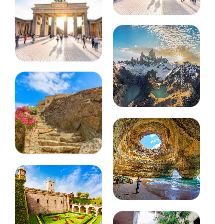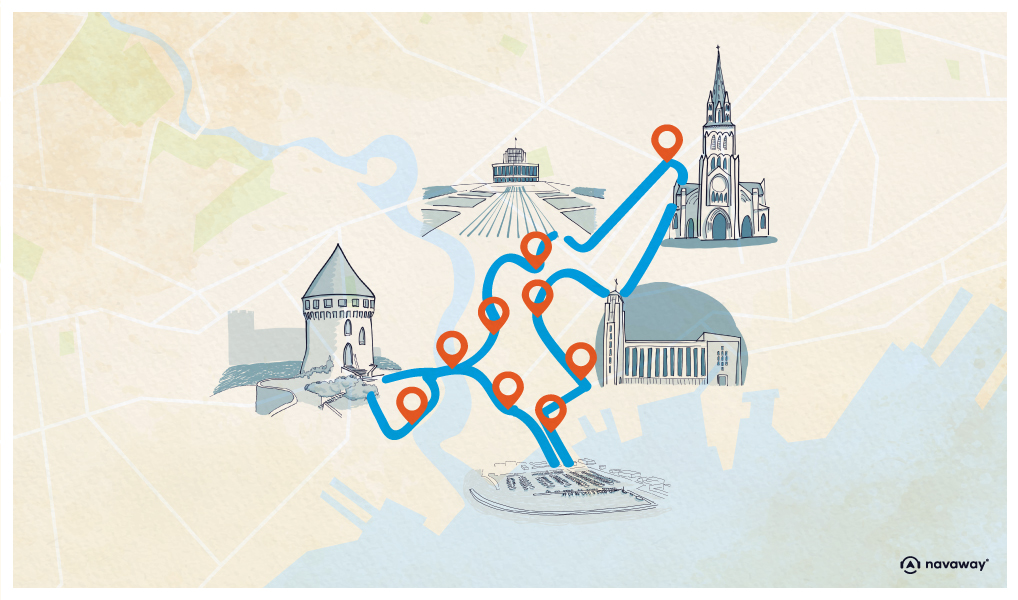
Visiting Crozon: 8 must-dos
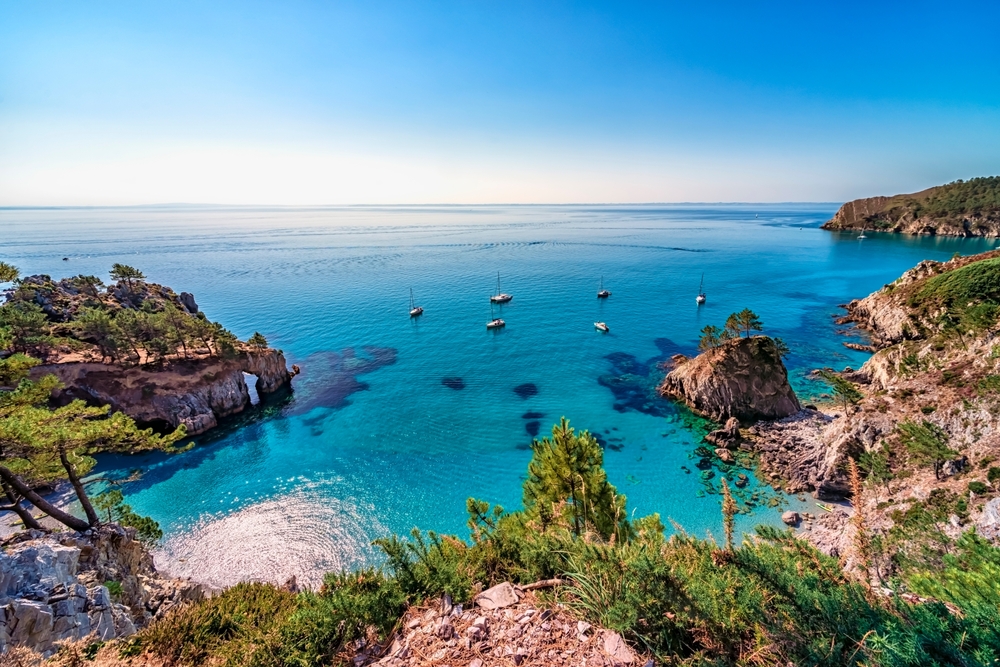
Situated at the westernmost tip of Brittany, the Crozon peninsula juts majestically into the Iroise Sea, offering breathtaking scenery where steep cliffs plunge into turquoise waters. Part of the Armorique Regional Nature Park, this wild and unspoilt land is home to a wealth of natural and heritage treasures, making it one of Finistère’s most popular destinations. Between spectacular rocky peaks, fine sandy beaches, mysterious sea caves and picturesque villages, a visit to Crozon means discovering an area where nature reigns supreme. Whether you’re a keen hiker on the GR34, a history buff or simply in search of exceptional panoramas, the Crozon peninsula promises an unforgettable experience at the end of the Breton world.

See also the Brittany guide :
- Visit Brest: The Capital of the Oceans
- 20 must-do things to do in Finistère
- Top 10 culinary specialities in Brest
- Top 5 hotels to stay in Brest
- 12 unusual romantic weekends in Brittany
- 12 places to spend an unusual night in Brittany
- 22 must-do things to do in Cotes-d’Armor
- The 14 most beautiful walks around Saint-Malo
- Top 6 of the best seaside campsites in Brittany
- The most beautiful villages in Brittany
- Top 20 of Brittany’s most beautiful beaches for swimming this summer
1. Pointe de Pen-Hir and the Tas de Pois (pea heaps)
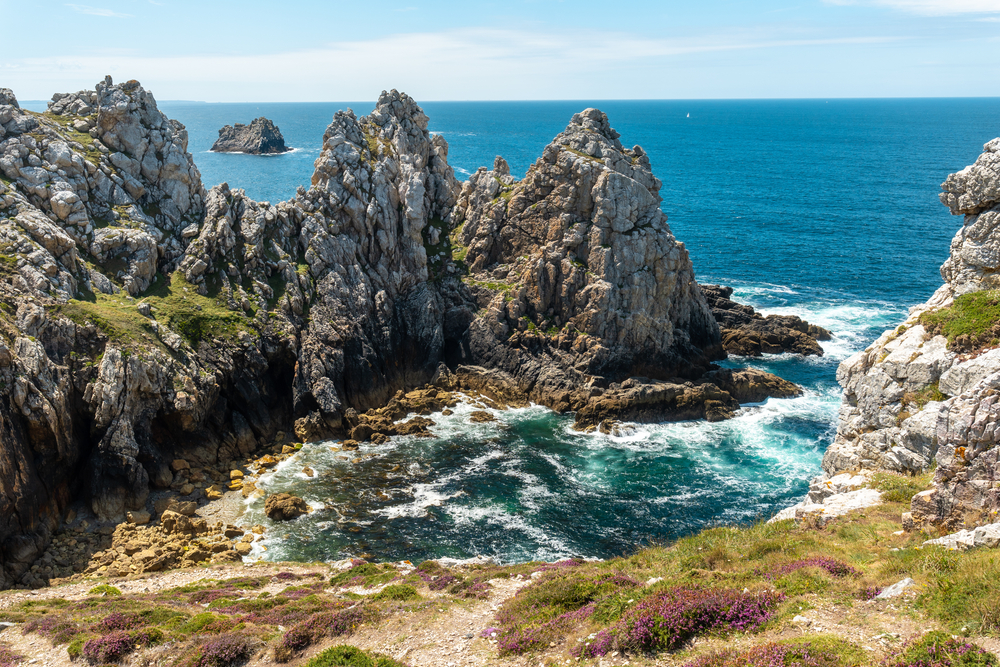
A true emblem of the Crozon peninsula, the Pointe de Pen-Hir offers one of the most spectacular panoramas in Brittany. Perched more than 60 metres above the Iroise Sea, this rocky outcrop allows you to admire a breathtaking landscape that stretches to the horizon. The highlight of this visit is undoubtedly the famous Tas de Pois, these imposing rocks emerging from the waves like so many stone sentinels. These spectacular geological formations, the remains of ancient cliffs eroded by the repeated assaults of the ocean, create a natural tableau of striking beauty.
At the top of the point stands the Monument aux Bretons, an imposing memorial in the shape of a Lorraine cross inaugurated by General de Gaulle in 1960. This monument pays tribute to the Breton soldiers who fell in the Second World War, and offers a privileged view of the whole site. There are a number of hiking trails along the coast to explore the surrounding area. The GR34, the famous customs path, crosses the headland and offers changing views of the cliffs and the ocean. Be careful, however, to stay alert near the shore, as the cliffs can be steep and the gusts of wind powerful. To make the most of this majestic site, it’s best to visit at the end of the day, when the setting sun sets the rocks in an unforgettable golden light.
2. Cap de la Chèvre
At the southern end of the Crozon peninsula, Cap de la Chèvre (Beg ar C’haor in Breton) is another must-see natural gem. This rugged headland closes off the bay of Douarnenez to the north and offers 180-degree panoramic views over the ocean. The cape is characterised by its moorlands carpeted with gorse and heather, which come to life in brilliant colours in spring and summer, creating a striking contrast with the deep blue of the sea.
A circular walk of around 8.5 kilometres allows you to explore the cape in all its splendour. The path winds along the cliffs, offering spectacular views of the jagged coastline and rocky islets. On a clear day, you can see the coast of Douarnenez and the whole of Cap Sizun in the distance. The site is also famous for its semaphore, a maritime surveillance station that is still in operation. Take binoculars with you to observe the marine wildlife: seals, dolphins and various species of seabirds are regular visitors to these waters. Cap de la Chèvre is particularly popular with photographers, who find exceptional natural compositions, especially at sunrise and sunset.
3. Île Vierge beach
Nestling in a green setting near the Pointe de Saint-Hernot, the Ile Vierge beach is a veritable little paradise on the Crozon peninsula. This intimate cove boasts translucent waters of turquoise hues that have nothing to envy of Mediterranean beaches. The fine golden sand invites you to relax, while the surrounding rocks create an unspoilt, authentic atmosphere.
Snorkellers will particularly appreciate this spot when sea conditions are calm. The rocky seabed is home to some interesting biodiversity. For hikers, a coastal path climbs above the beach and leads to the pointe de Saint-Hernot, offering a bird’s-eye view of the cove and the sea horizon. A walk eastwards from the Île Vierge beach reveals other small, secret and wild coves. Access to the beach requires descending a steep path, which helps to preserve its wild character and keep crowds to a minimum. This makes it an ideal destination for those seeking peace and quiet and authenticity. Don’t forget to come early in the high season to enjoy the peace and quiet.
4. The sea caves of Morgat
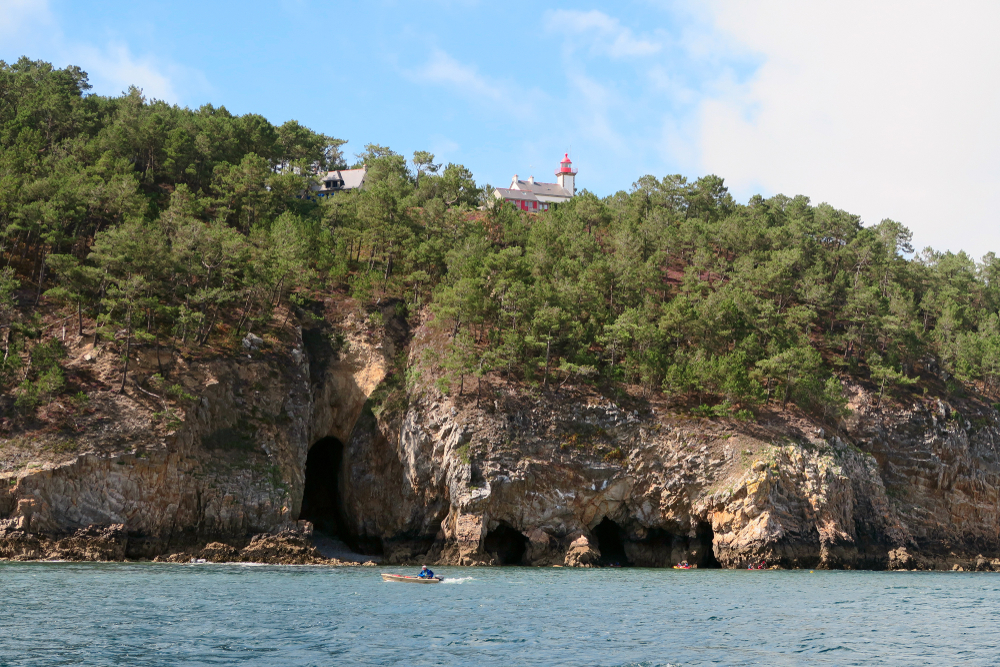
The village of Morgat, a well-known seaside resort on the peninsula, is famous for its spectacular sea caves carved into the Armorican sandstone cliffs. These natural caves, shaped by marine erosion over thousands of years, are one of Crozon’s major geological curiosities. One of the most remarkable is the Grotte de l’Autel, with its impressive size (80 metres deep) and flamboyant ochre colours, while the Grotte Sainte-Marine is accessible on foot during high tides.
There are several options for discovering these natural wonders. Boat trips from the port of Morgat allow you to explore the caves from the sea, offering a unique perspective on these natural cathedrals. The guides will tell you all about the Breton legends associated with these mysterious places. For the more adventurous, some caves can be visited by sea kayak, a more intimate and sporting experience. Grotte de l’Autel, the largest of the caves, fascinates visitors with its exceptional acoustics and the play of light reflected on its walls. Beyond the caves, Morgat is well worth a visit for its relaxed seaside atmosphere, its beautiful arched beach and its lively marina lined with fishing boats and sailing ships.
5. The megalithic alignments of Lagatjar
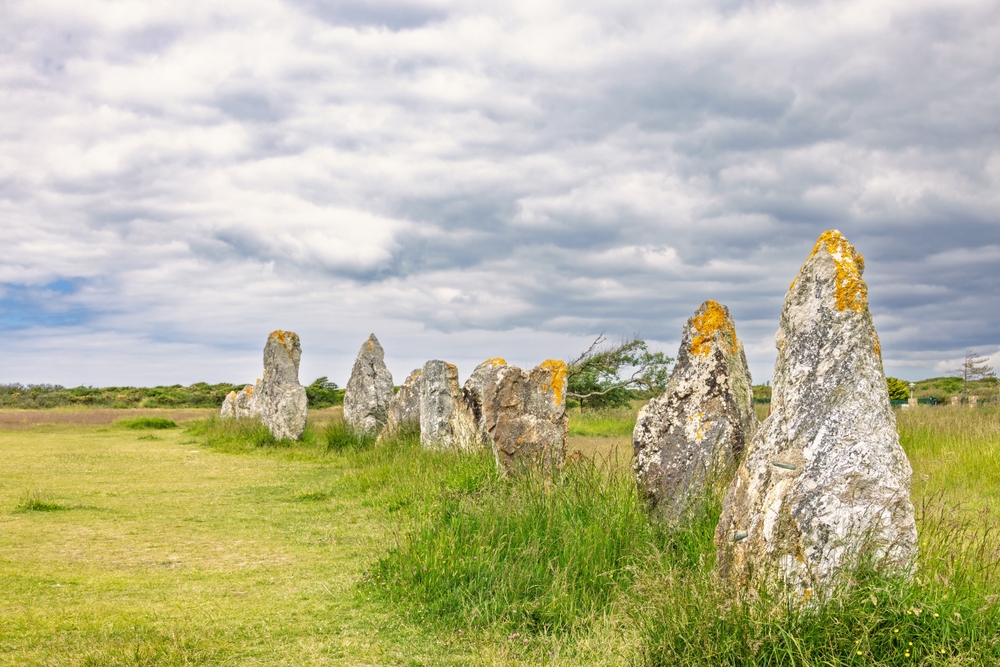
Mysterious witnesses to a thousand years of history, the Lagatjar alignments in Camaret-sur-Mer are one of the most impressive megalithic sites on the Crozon peninsula. These 87 menhirs standing on flat ground facing the Iroise Sea date back to the Neolithic period, more than 5,000 years ago. Some of these standing stones are up to 3 metres high, creating an enigmatic landscape that raises questions about the ritual practices of our ancestors.
Listed as a Historic Monument since 1883, the site was restored between 1928 and 1929, allowing some of the menhirs that had fallen over the centuries to be straightened. Originally, the alignment probably comprised several hundred stones, but many have disappeared, reused in buildings or simply scattered. The exact function of these alignments remains open to debate: astronomical observatory, place of worship, territorial marker? The mystery remains and adds to the fascination of the site. Free access to the site allows you to wander among the stones and feel the special atmosphere that emanates from them. To extend your discovery of the megalithic heritage, don’t miss the Ty ar Chur site (Maison du Curé) to the south of Morgat, another more discreet but just as intriguing alignment, with dozens of stones scattered over almost 300 metres.
6. Camaret-sur-Mer and its Vauban Tower
The charming port of Camaret-sur-Mer embodies the maritime soul of the Crozon peninsula. This fishing village with its authentic character has managed to preserve its heritage while opening up to tourism. Its most emblematic symbol is the Vauban Tower, listed as a UNESCO World Heritage Site as one of Vauban’s fortifications. Built at the end of the 17th century to plans drawn up by the famous military architect, this red-brick polygonal tower stands proudly on the Sillon, a spit of pebbles that protects the harbour.
The Vauban Tower can be visited and offers an exceptional panoramic view of Camaret harbour, the port and the peninsula. Next to it, the Notre-Dame de Rocamadour chapel adds a poetic touch to the picture, especially when the sun sets over the harbour. The port itself is well worth a stroll: traditional fishermen’s cottages, seafood restaurants and colourful boats line the quayside. Don’t miss the Camaret Artists’ Quarter, a veritable open-air gallery since 1992. Around thirty artists, seduced by the light and atmosphere of the area, have set up their studios in the Saint-Thomas district. In high season (mid-June to mid-September), they open their doors to the public every day, allowing visitors to discover paintings, sculptures and other creations inspired by the wild beauty of the peninsula. To get a better idea of Camaret’s history and heritage, take the Navaway audioguide tour of Brittany’s towns and villages.
200 audioguided tours for cities all around the world
Download7. The Fort des Capucins in Roscanvel
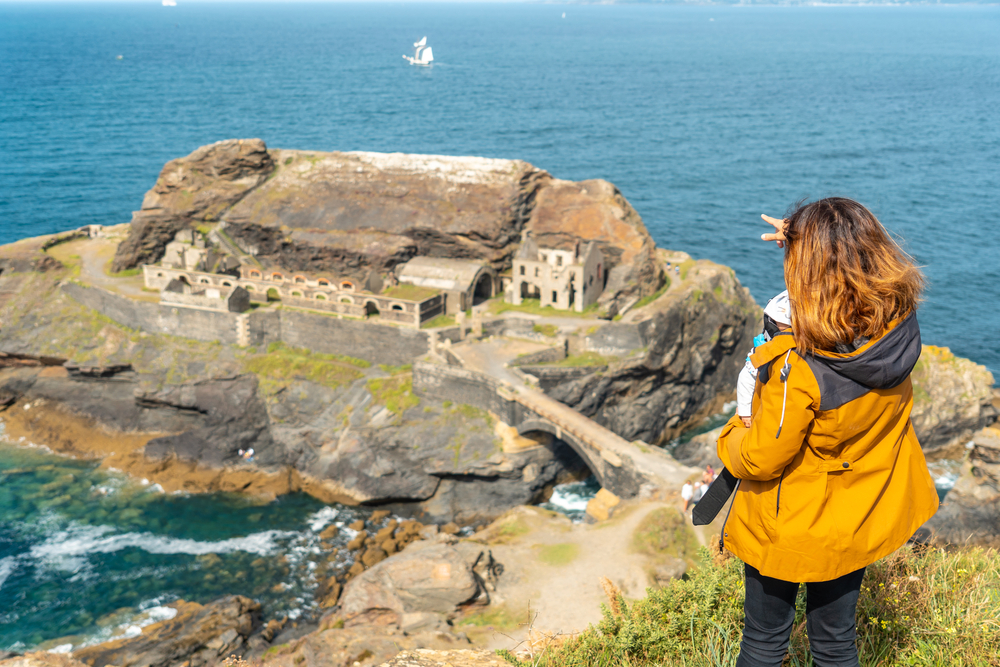
On the Roscanvel peninsula, at the entrance to the Brest Narrows, the Fort des Capucins is a striking architectural and natural sight. Built in the mid-19th century on an isolated rocky islet, this defensive military fort stands like a stone sentinel against the waves. The entire structure was carved out of the rock of the islet, testifying to the expertise of the military engineers of the time. Its strategic position enabled it to effectively control access to Brest harbour and Camaret cove.
An elegant arched bridge links the fort to the coast, creating an iconic image that is particularly photogenic. Although the fort is not open to visitors inside (it still belongs to the French Navy), its exterior architecture and surroundings are well worth a visit. You can admire the remains of the old barracks, the cannons still in place and traces of the small railway line that was once used for supplies. The site fits in perfectly with the GR34 trail that runs along the Roscanvel coastline, offering numerous viewpoints over the fort and the Iroise Sea. The area around the fort is also ideal for spotting marine life: seals and seabirds regularly visit these fish-filled waters. On a clear day, the view extends as far as Brest harbour and the surrounding islands.
8. A hike on the GR34
It’s impossible to visit Crozon without taking at least one section of the legendary GR34, also known as the customs trail. This long-distance footpath goes all the way round Brittany and crosses the Crozon peninsula along almost 144 kilometres of spectacular coastal paths. The route follows the steep contours of the coastline, offering breathtaking panoramas of cliffs, secret coves and extraordinary rock formations.
One of the most remarkable sections is the stretch between Morgat and Cap de la Chèvre, which combines wild beauty with a diversity of landscapes. The path winds its way between flower-filled moorland and vertiginous cliffs, revealing exceptional views over the Bay of Douarnenez. Another not-to-be-missed section links Camaret-sur-Mer to the Pointe de Pen-Hir, passing the Lagatjar alignments before reaching the spectacular site of the Tas de Pois. For a shorter but just as memorable walk, the route from the Pointe de Saint-Hernot to the Île Vierge (around 4 kilometres) offers a summary of the peninsula’s beauty, accessible to all abilities. The GR34 at Crozon has a moderate but constant gradient, with numerous steps and rocky passages that require a good level of fitness. Take good hiking boots, plenty of water and protection from the sun, as there are few shady areas on the coastal sections. The trail is well signposted in red and white, so you can venture out with confidence, supported by theNavaway app, which adds geological, historical and naturalist information to your hike.
In conclusion, the Crozon peninsula is an exceptional destination for lovers of wild nature and authentic heritage. With its spectacular rocky peaks offering breathtaking panoramas, crystal-clear beaches, fascinating sea caves and picturesque villages steeped in history, a visit to Crozon promises total immersion in the most authentic Brittany. The area lends itself perfectly to hiking along the famous GR34, as well as offering enriching cultural breaks at the thousand-year-old megaliths or the Vauban fortifications. Whether you’re here for a rejuvenating weekend or a longer, more in-depth exploration, the Crozon peninsula will win you over with its raw, unspoilt beauty.
FAQ – Visiting the Crozon peninsula
When is the best time to visit Crozon?
The ideal period is from May to September, when the climate is pleasant and the long days are ideal for hiking. July and August are the busiest months. To avoid the crowds and still enjoy good conditions, opt for June or September.
How long does it take to visit the Crozon peninsula?
A weekend is all it takes to discover the main must-see sites. For a more in-depth exploration, including several hikes along the GR34 and visits to the villages, allow 4 to 5 days. A full week will allow you to take full advantage of the area and its surroundings.
How to get to Crozon
By car, the peninsula is accessible via the D791 (from the north) and D887 (from the south), linked to the N165. By public transport, regular coach services link Brest and Quimper to Crozon and Camaret. A maritime shuttle (the Breesto) also connects Brest to the Freight in 30 minutes. The nearest airports are Brest and Quimper.
Can you swim on the beaches of Crozon?
Yes, the peninsula has many beaches where you can swim, including Morgat beach, Île Vierge and Pen-Hat beach. The water is cool even in summer (16-19°C) but still very pleasant on sunny days. Beware of the currents on some exposed beaches and follow the safety instructions.
Is the GR34 accessible to all abilities?
The GR34 on the Crozon peninsula has sections of varying difficulty. Some short sections, such as Saint-Hernot – Île Vierge, are accessible to families, while other longer sections require a good level of fitness due to the uneven and sometimes rocky terrain. It is possible to split the routes according to your ability.
Where to stay on the Crozon peninsula?
The main accommodation options are concentrated in Crozon, Morgat, Camaret-sur-Mer and Roscanvel. There are hotels, B&Bs, campsites and holiday rentals to suit all budgets. In high season, it is advisable to book several months in advance, especially for accommodation with a sea view.
200 audioguided tours for cities all around the world
Download